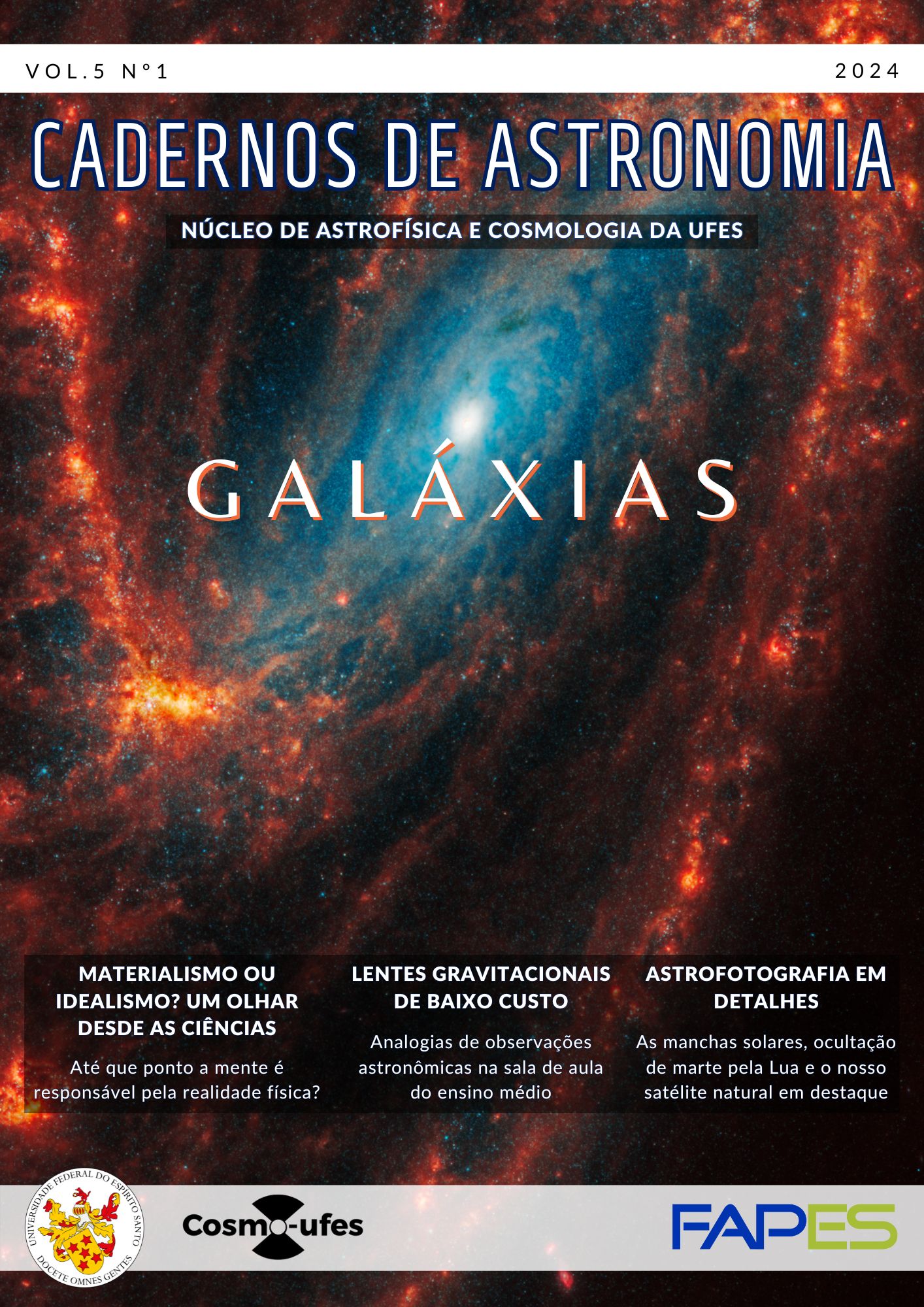Ultra-faint dwarf galaxies
DOI:
https://doi.org/10.47456/Cad.Astro.v5n1.43864Keywords:
dwarf galaxies, kinematic, dark matter, metalicity, star formationAbstract
The first ultra-faint dwarf galaxy UFD was discovered in the Sloan Digital Sky Survey (SDSS) in 2005, beginning a search that led to the discovery of several tens of similar dwarf galaxies. They are a continuation of the classical dwarf spheroidal galaxies known before SDSS towards lower luminosities and lower metallicities. The study of stellar kinematics revealed that UFD galaxies have more dark matter than the classical dwarf galaxies. Spectroscopic observations show that the stars within UFD galaxies are among the oldest and most metal-poor stars known. The abundances of iron Fe and other chemical elements show large spread due to extended star formation in the past. The analysis of individual stars in UFD galaxies in a small stellar mass interval is consistent with the hypothesis that large numbers of massive stars were formed in UFD galaxies and that the process of star formation ended at the epoch of reionization of the universe at redshift z ∼ 6. Once the UFD galaxies are the oldest and most dark matter-dominated known stellar systems, they are excellent laboratoriesto study formation of the first galaxies in the universe as well as the behaviour of dark matter on small scales.
Downloads
References
[1] M. Jones e R. Lambourne, An Introduction to Galaxies and Cosmology (Cambridge University Press, Cambridge, UK, 2004).
[2] J. Silk, O Big Bang - A origem do Universo (Universidade de Brasília, 1988).
[3] S. van den Bergh, The Galaxies of the Local Group (Cambridge University Press, 2007).
[4] B. Willman et al., A new Milky Way companion: unusual globular cluster or extreme dwarf satellite?, The Astronomical Journal 129(6), 2692 (2005). DOI: https://doi.org/10.1086/430214
[5] B. Willman e J. Strader, “Galaxy,” defined, The Astronomical Journal 144(3), 76 (2012). DOI: https://doi.org/10.1088/0004-6256/144/3/76
[6] J. D. Simon, The faintest dwarf galaxies, Annual Review of Astronomy and Astrophysics 57(1), 375 (2019). DOI: https://doi.org/10.1146/annurev-astro-091918-104453
[7] A. Drlica-Wagner et al., Eight ultra-faint galaxy candidates discovered in year two of the dark energy survey, The Astrophysical Journal 813(2), 109 (2015).
[8] R. R. Muñoz et al., A MegaCam survey of outer halo satellites. III. Photometric and structural parameters, The Astrophysical Journal 860(1), 66 (2018). DOI: https://doi.org/10.3847/1538-4357/aac16b
[9] S. E. Koposov et al., Snake in the Clouds: a new nearby dwarf galaxy in the Magellanic bridge, Monthly Notices of the Royal Astronomical Society 479(4), 5343 (2018). DOI: https://doi.org/10.1093/mnras/sty1772
[10] B. Willman et al., Willman 1 — a probable dwarf galaxy with an irregular kinematic distribution, The Astronomical Journal 142(4), 128 (2011). DOI: https://doi.org/10.1088/0004-6256/142/4/128
[11] W. E. Harris, A catalog of parameters for globular clusters in the Milky Way, Astronomical Journal 112, 1487 (1996). DOI: https://doi.org/10.1086/118116
[12] J. T. Kleyna et al., Ursa Major: a missing low-mass CDM halo?, The Astrophysical Journal 630(2), L141 (2005). DOI: https://doi.org/10.1086/491654
[13] R. R. Muñoz et al., Exploring halo substructure with giant stars: the dynamics and metallicity of the dwarf spheroidal in Boötes, The Astrophysical Journal 650(1), L51 (2006). DOI: https://doi.org/10.1086/508685
[14] N. F. Martin et al., A Keck/DEIMOS spectroscopic survey of faint Galactic satellites: searching for the least massive dwarf galaxies, Monthly Notices of the Royal Astronomical Society 380(1), 281 (2007). DOI: https://doi.org/10.1111/j.1365-2966.2007.12055.x
[15] J. D. Simon e M. Geha, The kinematics of the ultra-faint Milky Way satellites: solving the missing satellite problem, The Astrophysical Journal 670(1), 313 (2007). DOI: https://doi.org/10.1086/521816
[16] J. Wolf et al., Accurate masses for dispersion-supported galaxies, Monthly Notices of the Royal Astronomical Society 406(2), 1220 (2010). DOI: https://doi.org/10.1111/j.1365-2966.2010.16753.x
[17] A. P. Ji et al., R-process enrichment from a single event in an ancient dwarf galaxy, Nature 531(7596), 610 (2016). DOI: https://doi.org/10.1038/nature17425
[18] A. Koch et al., Neutron-capture element deficiency of the Hercules dwarf spheroidal galaxy, Astronomy & Astrophysics 554, A5 (2013). DOI: https://doi.org/10.1051/0004-6361/201220742
[19] R. K. Madejsky, Curso Básico de Astrofísica e Cosmologia, vol. 2 – Das galáxias aos quasares (UEFS Editora, Feira de Santana, 2015).
[20] R. Madejsky, Curso Básico de Astrofísica e Cosmologia, vol. 1 – O sistema solar, as estrelas e a Via Láctea (UEFS Editora, Feira de Santana, 2014).
[21] R. K. Madejsky, Buracos negros supermassivos: III. Sagitário A* no centro da Via Láctea, Caderno de Física da UEFS 20(1), 1404.1–8 (2023). DOI: https://doi.org/10.13102/cadfsuefs.v20i01.9263
[22] M. Geha et al., The least-luminous galaxy: spectroscopy of the Milky Way satellite Segue 1, The Astrophysical Journal 692(2), 1464 (2009). DOI: https://doi.org/10.1088/0004-637X/692/2/1464
[23] E. N. Kirby et al., The universal stellar mass-stellar metallicity relation for dwarf galaxies, The Astrophysical Journal 779(2), 102 (2013). DOI: https://doi.org/10.1088/0004-637X/779/2/102
[24] L. C. Vargas et al., The distribution of alpha elements in ultra-faint dwarf galaxies, The Astrophysical Journal 767(2), 134 (2013). DOI: https://doi.org/10.1088/0004-637X/767/2/134
[25] D. Webster, R. Sutherland e J. Bland-Hawthorn, Ultrafaint dwarfs — star formation and chemical evolution in the smallest galaxies, The Astrophysical Journal 796(1), 11 (2014). DOI: https://doi.org/10.1088/0004-637X/796/1/11
[26] D. R. Weisz et al., The star formation histories of local group dwarf galaxies. I. Hubble space telescope/wide field planetary camera 2 observations, The Astrophysical Journal 789(2), 147 (2014). DOI: https://doi.org/10.1088/0004-637X/789/2/147
[27] B. W. Carroll e D. A. Ostlie, An Introduction to Modern Astrophysics (Cambridge University Press, San Francisco, 2007).
[28] T. M. Brown et al., The primeval populations of the ultra-faint dwarf galaxies, The Astrophysical Journal Letters 753(1), L21 (2012). DOI: https://doi.org/10.1088/2041-8205/753/1/L21
[29] T. M. Brown et al., The quenching of the ultra-faint dwarf galaxies in the reionization era, The Astrophysical Journal 796(2), 91 (2014). DOI: https://doi.org/10.1088/0004-637X/796/2/91
[30] M. S. Bovill e M. Ricotti, Pre-reionization fossils, ultra-faint dwarfs, and the missing galactic satellite problem, The Astrophysical Journal 693(2), 1859 (2009). DOI: https://doi.org/10.1088/0004-637X/693/2/1859
Downloads
Published
How to Cite
Issue
Section
License
Copyright (c) 2024 Rainer K. Madejsky

This work is licensed under a Creative Commons Attribution 4.0 International License.






